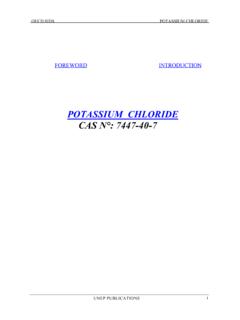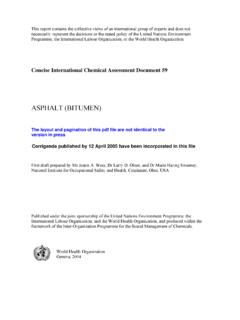Transcription of MICA Freeform - Microfabrica
1 M A T E R I A L S D O S S I E R 1 MICA Freeform BIOCOMPATIBILITY REPORT M A T E R I A L S D O S S I E R 2 Biocompatibility 3 Palladium Valloy-120 Sterility 17 Palladium Valloy-120 Corrosion 19 Palladium Valloy-120 MATERIALS DOSSIER B I O C O M PAT I B I L I T Y M A T E R I A L S D O S S I E R 3 Introduction The primary standard for biological evaluation of medical devices is International Standard ISO 10993. An overview of test requirements is provided in ISO 10993-1:2003(E) [Reference 1]. For both ISO and FDA, the chart shown in Appendix 1 [Reference 2] applies. For the Japanese Ministry of Health and Welfare, the chart shown in Appendix 2 [Reference 2] applies. The categorization of medical devices according to the nature and duration of contact with the body is very similar between the ISO/FDA and Japanese MHW guidelines, though there are some differences with respect to specific test procedures and protocols.
2 Microfabrica has opted to test its materials according to the criteria for a permanent implant device having blood contact (shown as the bottom row in the tables of Appendices 1 and 2). Per both tables, the prescribed tests are therefore: Cytotoxicity Sensitization Irritation or intracutaneous reactivity Acute systemic toxicity Subacute and subchronic toxicity Genotoxicity Pyrogen Implantation Haemocompatibility Chronic toxicity Carcinogenicity Figure 1. Single layer Pd test specimen. Biocompatibility of Palladium M A T E R I A L S D O S S I E R 4 Brief descriptions of these tests are provided in Appendix 3. Suggestions for specific tests to perform from the above list, as well as test protocols, were made by the primary independent testing lab performing the biocompatibility tests (Wuxi AppTec) and Microfabrica consultants. The resulting test plan proceeded as follows: tests were performed using single-layer test specimens such as the perforated square shown in Figure 1.
3 Implantation tests were performed with non-perforated disk-shaped test specimens that were steam sterilized. In the case of the pyrogen test, it was performed using a three-layer specimen sterilized using the irradiation method. All tests were performed non-GLP (Good Laboratory Practice) since the tests were aimed at characterizing MICA Freeform materials, rather than final devices. The MEM Elution test for cytotoxicity was selected. An intracutaneous reactivity test was selected. The Ames test was selected as the only genotoxicity test to be performed. Implantation tests in rabbit muscle were chosen to be for 2 and 12-week duration. Haemocompatibility tests were chosen to encompass direct contact hemolysis (ASTM), platelet and leukocyte counts, and partial thromboplastin time. Chronic toxicity and carcinogenity tests were not performed. Extraction protocols were chosen to be 121 C for 1 hr. Extraction vehicles and sterilizations were chosen as follows: Normal saline and cottonseed oil for the sensitization test (no sterilization) Normal saline and cottonseed oil for the acute systemic injection test (steam) Normal saline and cottonseed oil for the intracutaneous reactivity test (steam) Normal saline for the pyrogen test (radiation) Normal saline for the subchronic intravenous toxicity test (steam) Cottonseed oil for the subacute intraperitoneal toxicity test (steam) Saline/dimethylsulfoxide for the Ames test (no sterilization) E-MEM for the MEM Elution cytotoxicity test (steam) Extraction ratios were chosen to be 4g/20 mL, 60 cm2/20 mL, 120 cm2/20 mL, and 4 cm2/1 mL, 21 cm2/7 mL, depending on the test.
4 Biocompatibility of Palladium M A T E R I A L S D O S S I E R 5 Biocompatibility of Palladium Test Result Cytotoxicity (ISO) Excellent: 0 cytotoxicity score, no cell lysis, non-toxic Sensitization (ISO maximization) Excellent: 0% sensitization response Intracutaneous irritation (ISO) Excellent: Negligible primary irritation index Acute systemic toxicity (USP, ISO) Excellent: No evidence or systemic toxicity Subacute intraperitoneal toxicity (ISO) Excellent: Negative for signs of systemic toxicity Subchronic intravenous toxicity (ISO) Excellent: Negative for signs of systemic toxicity Ames mutagenicity (ISO) Excellent: Non-mutagenic Pyrogen (ISO) Excellent: Non-pyrogenic 2- and 12-week rabbit muscle implantation (ISO) Excellent: Non-Irritant Haemocompatibility Hemolysis (ASTM) Excellent: Hemolytic index (non-hemolytic) Haemocompatibility Partial thromboplastin time (ISO) Excellent: Non-activator of intrinsic coagulation pathway Haemocompatibility Platelet and leukocyte counts (ISO) Excellent: Equivalent to HDPE Test results The results of testing the biocompatibility of palladium are shown in Table 1.
5 Table 1. Test results for Microfabrica palladium M A T E R I A L S D O S S I E R 6 Biocompatibility of Palladium Conclusions The test results summarized in Table 1 indicate that palladium is a suitable material for short-term (<24 hours) exposure applications in manufacturing surface and external devices which work in contact with skin or mucosal membranes, breached or compromised surfaces, bone, dentin, and circulating blood. Palladium is also suitable for short- and long-term implanation in the body and the circulatory system. Since the material has good corrosion resistance, we do not consider that the material biocompatibility can be influenced by the sterilization method. For pyrogenecity, the biocompatibility result may be directly dependent on the sterilization method and the ability of this method to eliminate the pyrogenic effect induced by the water based processes. References [1] Biological evaluation of medical devices Part 1: Evaluation and testing, Third edition 2003-08-01, reference number ISO 10993-1:2003(E).
6 [2] Vasudev P. Anand, Biocompatibility Safety Assessment of Medical Devices: FDA/ISO and Japanese Guidelines , Medical Device & Diagnostic Industry, January 2000. Available online at M A T E R I A L S D O S S I E R 7 Appendix 1: ISO/FDA test chart [Reference 2] Biocompatibility of Palladium APPENDICES Device Categories Initial Evaluation Supplemental Evaluation Body Contact Contact Duration Cytotoxicity Sensitization Imitation or intracutaneous reactivity Systemic toxicity (acute) pyrogenicity Subchronic toxicity Genotoxicity Implantation Hemocompatability Chronic toxicity Carcinogenicity Surface Devices Skin A B C Mucosal Membrane A B C 0 0 0 0 0 0 Breached / compromised surface A B C 0 0 0 0 0 0 0 External Communicating Devices Blood path indirect A B C 0 0 0 Tissue / bone dentin communicating A B C 0 0 0 0 0 0 0 0 Circulating blood A B C 0 0 0 0 Implant Devices Bone / tissue A B C 0 0 0 0 0 0 0 Blood A B C 0 A = Limited exposure (< 24 hours) B = Prolonged exposure (24 hours - 30 days) C = Permanent contact (> 30 days) = FDA and ISO evaluation tests 0 = Additional tests for FDA M A T E R I A L S D O S S I E R 8 Appendix 2.
7 Japanese Ministry of Health and Welfare (MHW) test chart [Reference 2] Biocompatibility of Palladium APPENDICES Device Categories Initial Evaluation Supplemental Evaluation Body Contact Contact Duration Cytotoxicity Sensitization Imitation or intracutaneous reactivity Systemic toxicity (acute) pyrogenicity Subchronic toxicity Genotoxicity Implantation Hemocompatability Chronic toxicity Carcinogenicity Surface Devices Skin A B C Mucosal Membrane A B C 0 0 0 0 0 0 Breached / compromised surface A B C 0 0 0 0 0 0 0 External Communicating Devices Blood path indirect A B C 0 0 0 Tissue / bone dentin communicating A B C 0 0 0 0 0 0 0 0 Circulating blood A B C 0 0 0 0 Implant Devices Bone / tissue A B C 0 0 0 0 0 0 0 Blood A B C 0 A = Limited exposure (< 24 hours) B = Prolonged exposure (24 hours - 30 days) C = Permanent contact (> 30 days)
8 = FDA and ISO evaluation tests 0 = Additional tests for FDA M A T E R I A L S D O S S I E R 9 Biocompatibility of Palladium Appendix 3: Test Descriptions The following are brief descriptions of the tests described above. More detailed descriptions may be found in the ISO standard [Reference 1]. Cytotoxicity. Evaluates the material s effect on cell growth, cell depth, and other effects. Sensitization. Estimates the potential for contact sensitization; even small amounts of potential leachables can produce allergic or sensitization reactions. Irritation. Estimates the potential for irritation in a suitable model using sites such as skin, eye and mucous membranes. Intracutaneous reactivity. Assesses the localized reaction of tissue. Applicable when devices have access to circulating blood, etc. such that determination of irritation by dermal or mucosal tests are inappropriate. Acute systemic toxicity. Estimates, using an animal model, the potential harmful effects of single or multiple exposures during a brief period.
9 Subacute and subchronic toxicity. Determines the effects of single or multiple exposures for a period not less than 24 hours, and not greater than 10% of the life span of the animal used for testing. Genotoxicity. Uses cell cultures or other techniques to determine gene mutations, changes in chromosome structure or number, or other DNA or gene toxicities. Pyrogen. Assesses pyrogenic (fever-producing) reactions in test animals. Implantation. Evaluates local pathological effects on tissue at both gross and microscopic levels, of a specimen that is surgically implanted in appropriate tissue appropriate in a test animal. Haemocompatibility. Evaluates the effects of blood-contact with devices or materials. tests may assess the potential for hemolysis, thrombogenicity, etc. Chronic toxicity. Determines the effects of single or multiple exposures during at least 10 % of the life span of the test animal. Carcinogenicity. Assesses the tumorigenic potential during the major portion of a test animal s life span.
10 Carcinogenicity tests should be performed only if there are suggestive data from other sources. M A T E R I A L S D O S S I E R 10 Introduction The primary standard for biological evaluation of medical devices is International Standard ISO 10993. An overview of test requirements is provided in ISO 10993-1:2003(E) [Reference 1]. For both ISO and FDA, the chart shown in Appendix 1 [Reference 2] applies. For the Japanese Ministry of Health and Welfare, the chart shown in Appendix 2 [Reference 2] applies. The categorization of medical devices according to the nature and duration of contact with the body is very similar between the ISO/FDA and Japanese MHW guidelines, though there are some differences with respect to specific test procedures and protocols. Microfabrica has opted to test its materials according to the criteria for a permanent implant device having blood contact (shown as the bottom row in the tables of Appendices 1 and 2). Per both tables, the prescribed tests are therefore: Cytotoxicity Sensitization Irritation or intracutaneous reactivity Acute systemic toxicity Subacute and subchronic toxicity Genotoxicity Pyrogen Implantation Haemocompatibility Chronic toxicity Carcinogenicity Figure 1.




